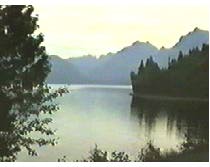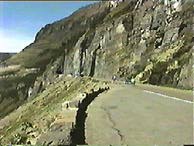 We wheel out of the KOA, down hill to the main road, a trail of blinking red Vista(tm) tail lights. Motorists will think they are seeing more than just double!
We wheel out of the KOA, down hill to the main road, a trail of blinking red Vista(tm) tail lights. Motorists will think they are seeing more than just double!
5 a.m. is starry and cold! Diane, sleeping in her van parked alongside the cabin, rustles about; Gordon, our alarm clock, provides gentle encouragement to get going. He is still on east coast time, so this god awful hour is easier for him.
I'm bundled in all the warm cycling clothes that I brought, glad to have it: ear muffs, scarf, Burley ultrex(tm) jacket, thermax(tm) cycling shirt, cotton t-shirt, biking shorts, black tights, rain pants, wool sox, neoprene booties (shoe covers), glove liners, and my claw-shaped gloves. Layers upon layers.
On to Lake McDonald and up Logan Pass!
 We wheel out of the KOA, down hill to the main road, a trail of blinking red Vista(tm) tail lights. Motorists will think they are seeing more than just double!
We wheel out of the KOA, down hill to the main road, a trail of blinking red Vista(tm) tail lights. Motorists will think they are seeing more than just double!
Well ensconced on Going To The Sun Road, I am enjoying the mixed-forest lined road, lost in thought. Gordon is far up the road, Chuck is somewhere ahead. I don't know where Diane is. She might be behind. A pack of near-early riders is further back.
An hour or so into the ride, I arrive at Lake McDonald stopping for a look at the lodge and lake, and to buy hot cocoa. Others are leaving as I pull in. Time seems not to be a factor. Surely I will make my 11 a.m. appointment with the top.
The ascent is gentle for the first 24 miles. Sun eventually brightens the bare granite peaks surrounding the valley we are climbing from. As I pedal upward, aspens turn from green to yellow. We are chasing autumn up the mountain.
I come around the bend termed "the loop" and begin the steeper ascent -- 12 miles of 5% grade. Expecting this to be steeper, I am reminded by another rider that it was designed for Model T Fords, which were unable to navigate steep roads.
Our support van is at the "7 miles to go" pullout, providing water and Pepsi's new Ultra Sport(tm) drink, cases of which were donated to Bike Centennial for this particular ride. More and more riders ask why I carry Rufus. Some day I'm going to create a helmet for him, a small set of tandem pedals near his feet, and a sign proclaiming, "My name is Rufus. I'm a touring bear." Of course if I did all of that, 90% of the conversation about him would disappear, and that's why he's along -- to generate conversation and provide moral support.
I stop to take pictures, gauging time left vs. miles to go. The views are spectacular --
 granite peaks raging skyward, some painted with glistening snow fields. There is considerable discussion about the mountain goats, symbol of Glacier Park, but I haven't seen any. Time seems to be under control.
granite peaks raging skyward, some painted with glistening snow fields. There is considerable discussion about the mountain goats, symbol of Glacier Park, but I haven't seen any. Time seems to be under control.
10:45 a.m. Steve drives by in the support van saying, "Nearly 3 miles to go." Hmm. At 5 mph, I am not going to make the pass in 15 minutes. It's simple arithmetic. I look at my watch - 11:15. Around each bend the top continues to be elusive. I pedal a constant 5 mph, unable to pedal faster, but feeling as if I'm ranger racing. I'm mentally comparing this to Connor Pass in Ireland; this is three times as long. Thoughts of lunch act as my carrot and motivate me upward.
At last the top! 6,600 ft. 11:31 a.m. No ranger! I made it!
Diane takes my picture in front of the Logan Pass Summit sign. I take a picture of Julian, the touring Brit, whose camera has broken. He has been part of the line of cyclists inching up the hill. His mountain bike is loaded with every imaginable item that could be carried a tour. As I talk with him I learn why. He'll be biking for nearly a year, from Alaska to Mexico.
While here, Diane and I hike to the top of the Hidden Lake overlook, a mile each direction. It feels good to exercise different muscle groups. The driftwood-colored boardwalk trails across the tundra, the sky brilliant blue, the air crisp. At an overlook people are clumped in the throes of a wildlife sighting. A young fuzzy white mountain goat scampers about with its attentive mom close by. Across the trail is another pair, that baby looking precariously young. An early winter may put it in mortal danger.
On the return, a herd of Rocky Mountain Big Horn sheep with grand brown horns circling the sides of their heads graze high on the mountainside. Wild flowers still bloom: red Indian paintbrush, red monkey flower, alpine fireweed, and others which I cannot identify. Curious marmots perch upright on rocks, their fat tummies providing ballast. They watch us watch them. Soon they will go into hibernation.
Near the Park's east entrance I take a detour from the rest of the riders and follow a sign pointing west: 1913 Ranger Cabin. I pedal slowly down a packed dirt road, enjoying a different view of the glacial peaks...a view most would not see, as we pedaled away from this view all day. At the end of the road a sign says, "Ranger Cabin closed." Back to the main road, thwarted in my mission but fulfilled in a deeper sense -- this small detour is my own journey, a customization of our pre-planned route.
Through the tiny town of St. Mary on the western edge of the Blackfeet Reservation, Diane calls down to me from the verandah of the general store where she is sipping a tall iced tea. I join her, unable to bypass the counter of homemade chocolate fudge. Mmm. My pedaling reward.
Camp is up a short hill into Johnson's RV and Camping Park. Yellowstone Kelly, our caterer for most all of the cycling days, is set up for dinner. It's good, plentiful, and filling. After dinner Angel gives a 45 minute wheel building demonstration, beginning with a rim, spokes, and hub. He has our undivided attention. I learn enough to think that perhaps if I HAD to replace a spoke on the road, I could do it well enough to limp to a bike shop for proper mechanical repair.
Since we are on the Blackfeet Reservation, Bike Centennial has arranged for Curly Bear Wagner, Blackfeet historian and Smithsonian Scholar, to speak to us on the cultural history of the Blackfeet Nation, through which we will be pedaling tomorrow. His lecture is fascinating!